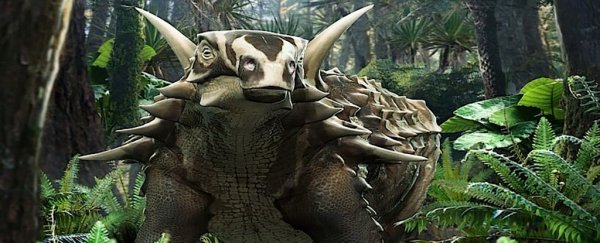Reanalyzing fossils can often lead to new discoveries, as has been the case with a study of an 80 million-year-old Late Cretaceous Struthiosaurus austriacus skull. A new analysis reveals the dinosaur was likely sluggish in its movements and was probably largely deaf as well.
Researchers used a high-resolution 3D scan of a partial braincase section – just 50 millimeters (nearly 2 inches) in diameter – of the creature's skull, holding the brain and other brain and neurosensory tissues. Researchers used micro-computed tomography (micro-CT), where X-rays build up a detailed cross-section of an object, to create the scan.
They found signs that the dinosaur probably didn't have the brain capacity to focus on potential predators due to the small flocculus part of the brain that does this job. That suggests that the plates and spikes on the body of the S. austriacus were enough to discourage any other animals looking for a meal.
"In contrast to its North American relative Euoplocephalus, which had a tail club and a clear flocculus on the brain cast, Struthiosaurus austriacus may rather relied on its body armor for protection," says paleontologist Marco Schade, from the University of Greifswald in Germany.
Further digging into the braincase scans revealed the semicircular canals in the inner ear were formed in such a way that suggests the dinosaur wasn't the most agile of its kind: These parts of the ear help control balance movement, and various conclusions can be drawn from them.
Also of note was the short lagena, which is actually the shortest lagena ever found in a dinosaur. The lagena is the part of the ear used as part of the listening system and suggests that S. austriacus wouldn't have been very good in the hearing department.
Using a set of equations linking hearing ranges with the features of this anatomy, the team calculated the dinosaur could only pick up on a limited range of frequencies of somewhere between 296 and 2,164 Hertz. By comparison, human hearing is typically from around 20 to 20,000 Hertz.
Unlike many dinosaurs, the researchers believe that this particular species would have kept itself to itself due to not being able to hear very well.
"These observations agree with an animal that adapted to a comparatively inactive lifestyle with limited social interactions," write the researchers in their published paper.
The group of dinosaurs that S. austriacus belongs to were known as 'living fortresses', and individuals in it could grow up to 8 meters (more than 26 feet) in body length, though the Struthiosaurus likely measured around 3 meters at most. Coming from the nodosaurid family, the creature would've been a herbivore.
Experts have also been able to make assessments of brain thermoregulation and neck mobility based on the form of the headcase, showing how this relatively small part of the fossil record can reveal a lot about the dinosaurs that they belonged to – and how certain species can be distinguished from others.
"Nodosaurids were possibly less reliant on their sense of hearing, applied a less active style of self-defense and, apparently, occupied different ecological niches than ankylosaurids," write the researchers. "The new findings of the neuroanatomy of Struthiosaurus austriacus seem to add to this differentiation."
The research has been published in Scientific Reports.
